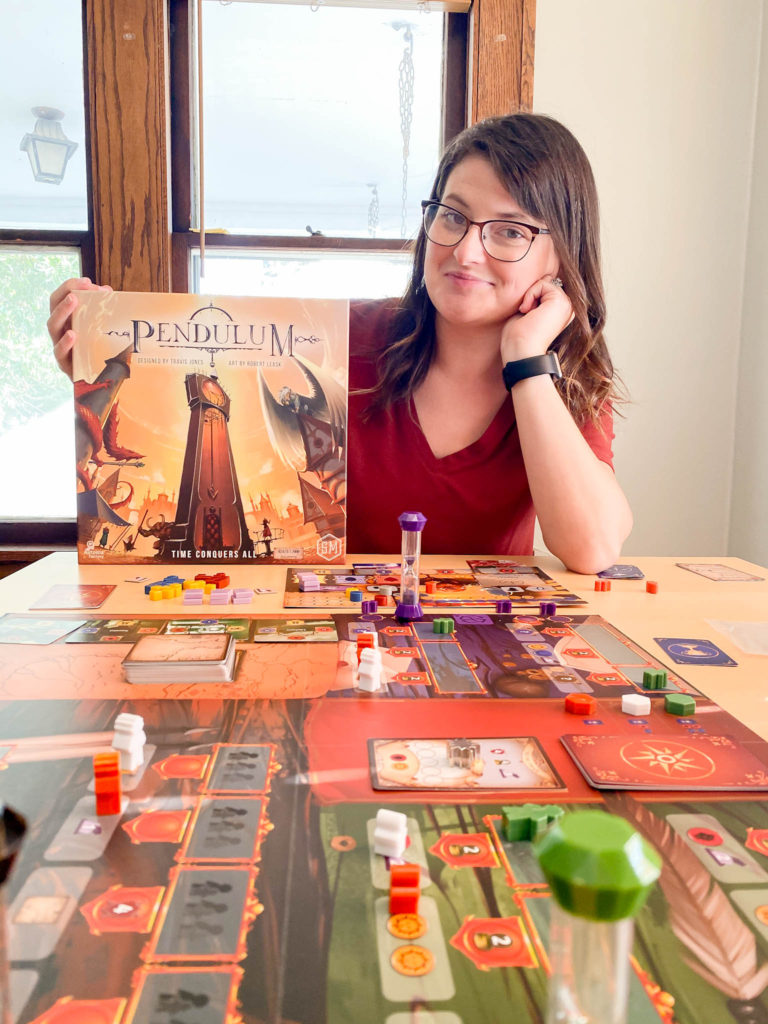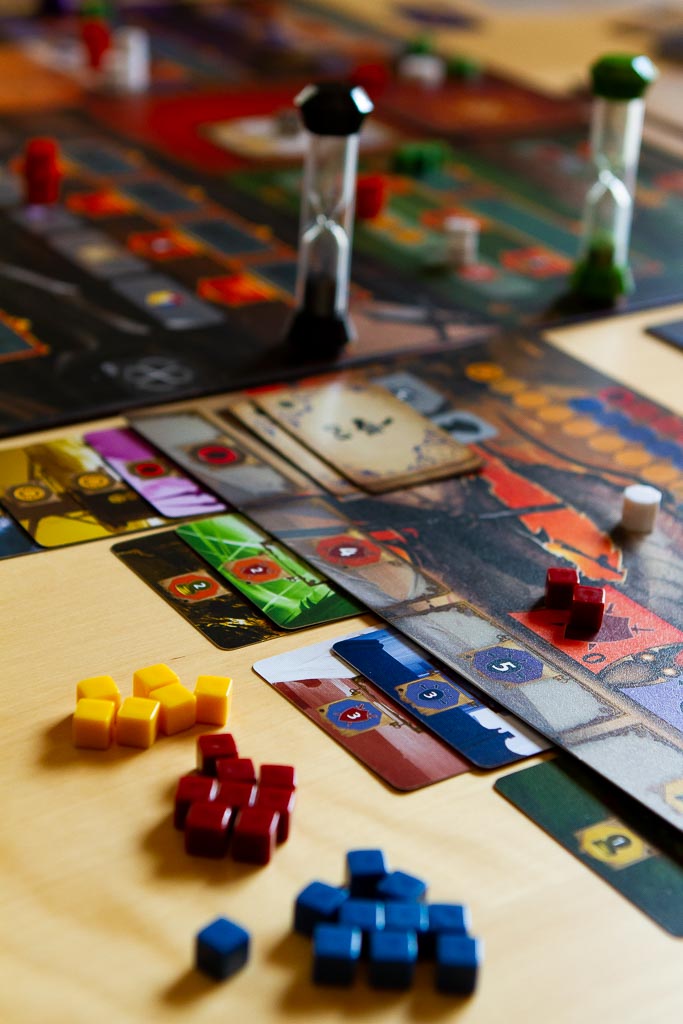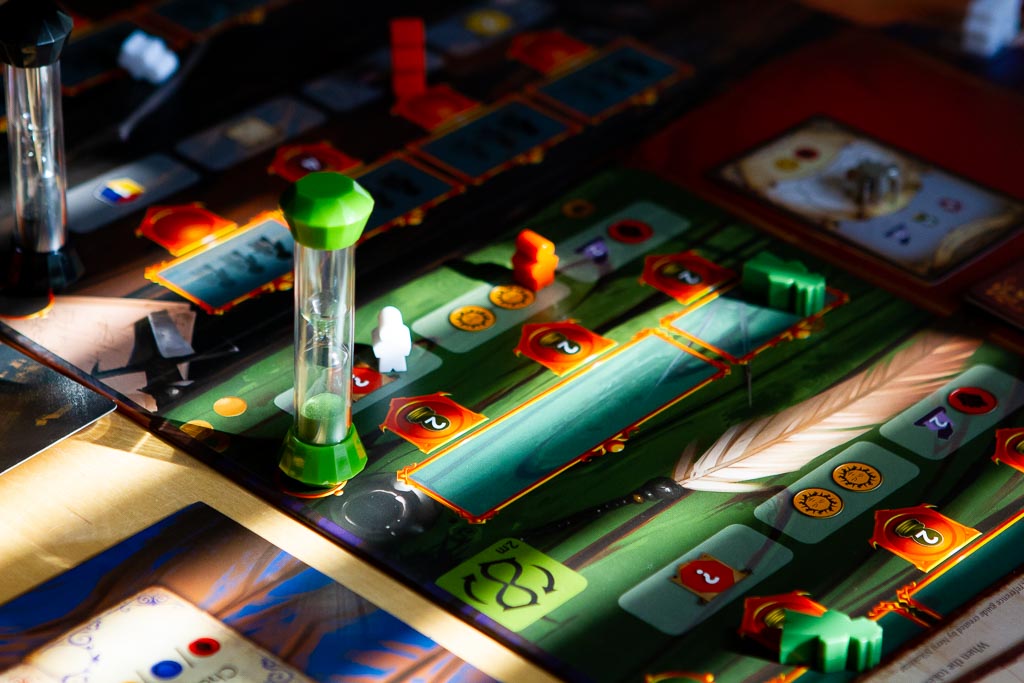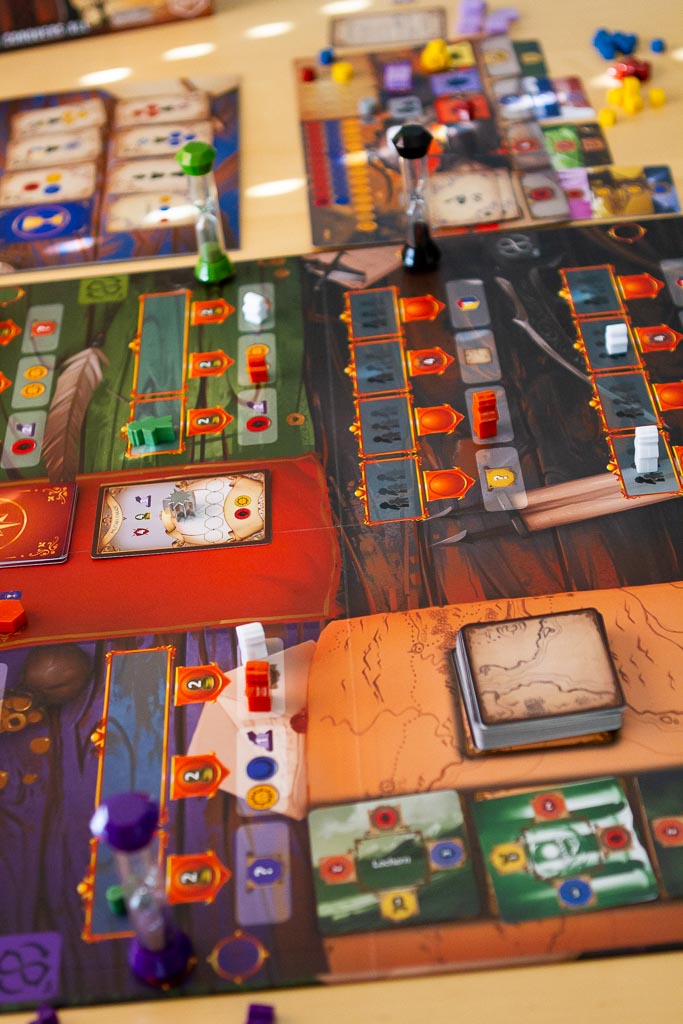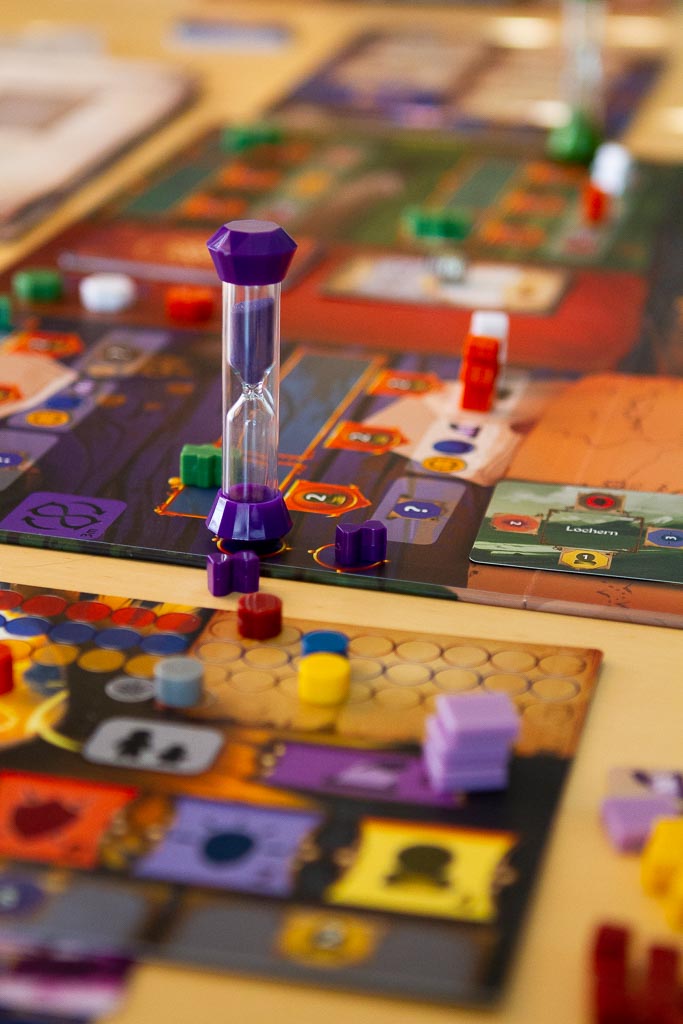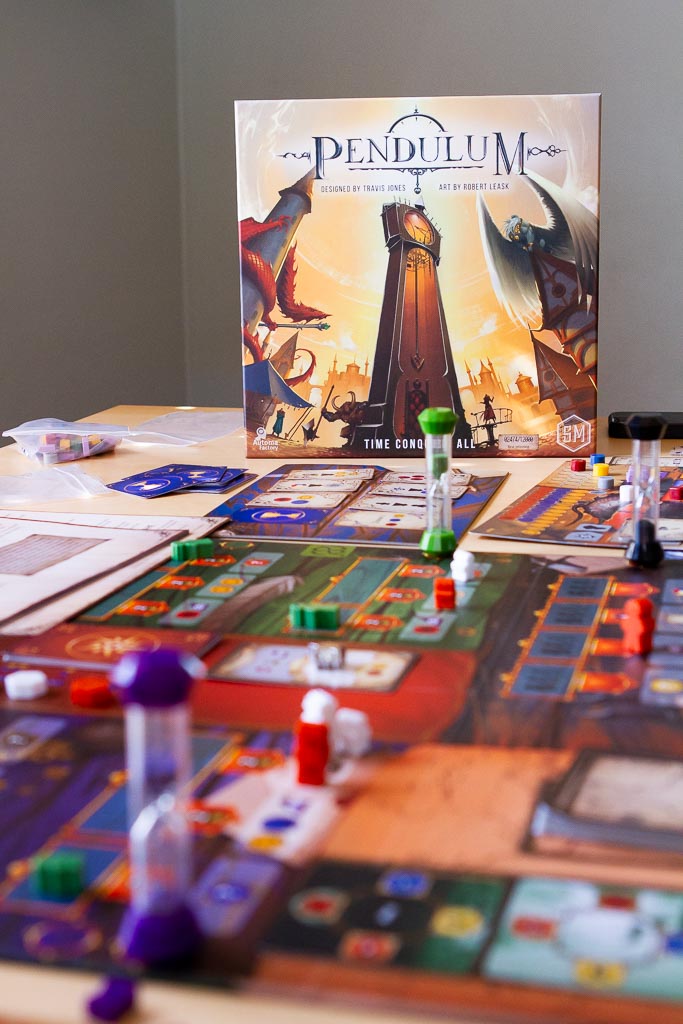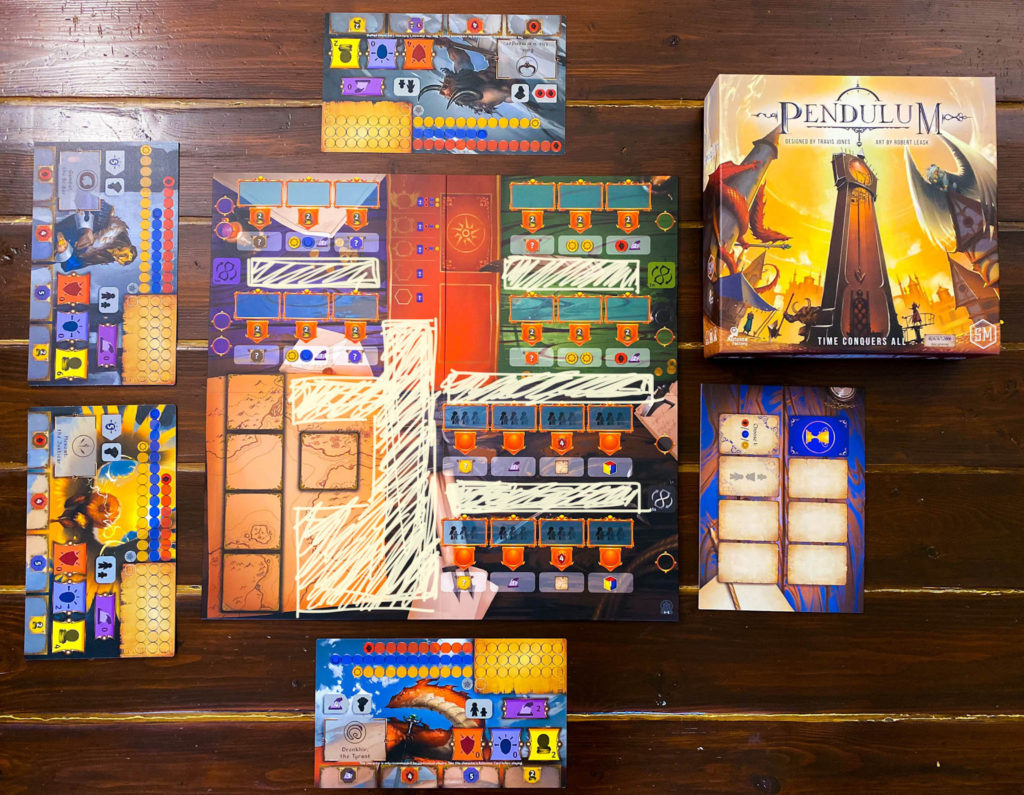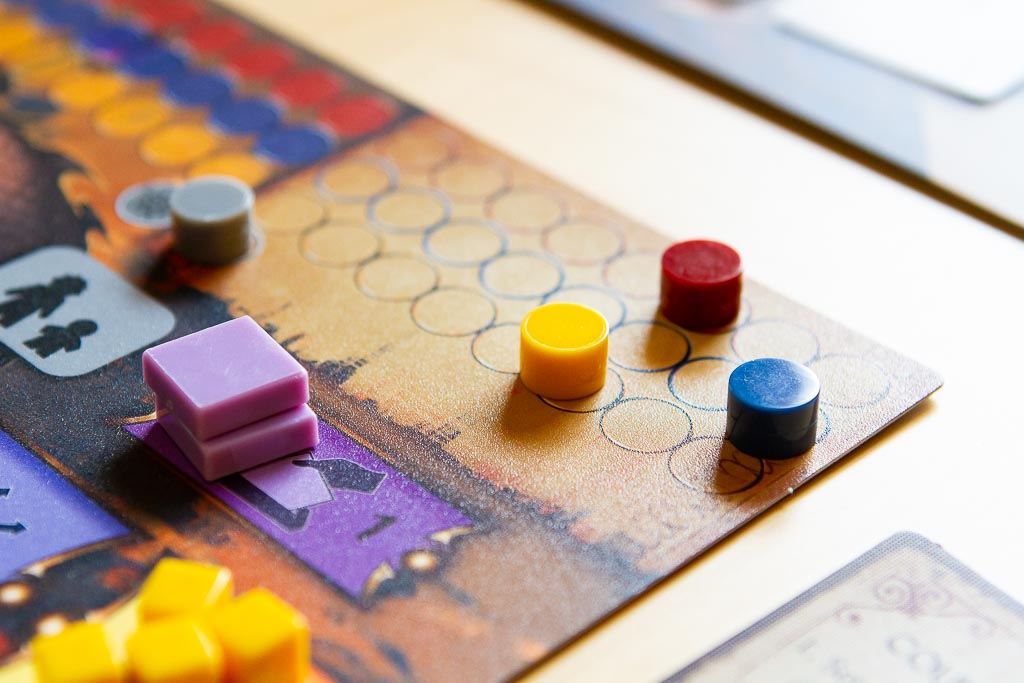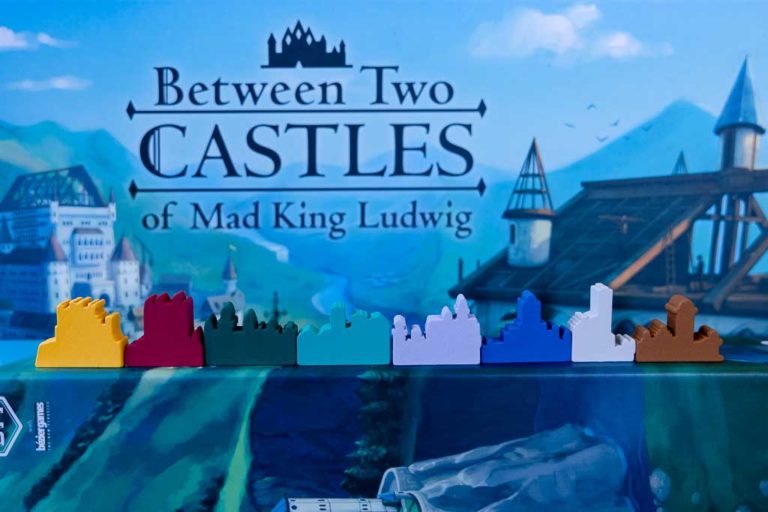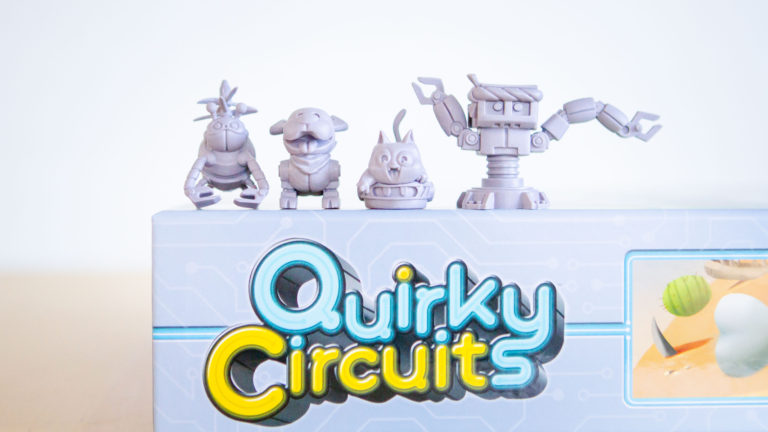If you hope to become the true ruler of Dünya, Time will be your most valuable resource.
Pendulum will have you thinking on your feet as you work quickly to take actions, advance your influence, and expand your provinces before the time runs out.
And much like a pendulum, our thoughts on this game swing back and forth and we’re telling you all about why in this review!
What is Pendulum?
Pendulum is a real-time worker placement game that plays out in real time. Players each have a set number of “worker” that they will use to assign to action spaces abiding by placement rules and restrictions. These workers then allow players to take those actions and gain the benefit.
Because pendulum is a real-time game, play happens simultaneously rather than in a sequential order. All players will be assigning their workers to action spaces at the same time, sometimes taking valuable spaces away from another player who must then wait until the space becomes available at a later time.
How Do You Play?
I want to quickly get to my review of Pendulum, but for that you need to know at least a little bit of how the game plays. So let me give you the bare bones run down.
Pendulum is played out in four rounds with the goal to move your victory point markers the farthest into the scroll section of your player board to win.
The first part of each round is the worker placement stage where players will place their workers and take actions in real time as the sand timers are flipped back and forth. There are three action selection areas of the board, each with its own timer. The purple timer is 3 minutes, the green timer 2, and the black timer 45 seconds. Each section has both an upper and lower actions. When a timer has run out, it is flipped to the either the upper or lower section depending on where it was.
When a timer is absent from a location, players may place their workers above action spaces, but they may not take the actions yet. As long as there is no timer present, players may move workers around and change their mind.
However, once a timer is empty, it can then be flipped to the opposite section. All workers in the section with the newly flipped timer may now begin taking their actions. (again, all players do this at the same time) After taking their actions however, those workers must remain there until the timer leaves. No worker is allowed to be moved when a timer is in its section.
There are many different types of actions players can take. Some of the benefits include but are not limited to: earning resources (money, military, influence;) moving your victory point markers forward; earning territory cards that you can use to put under your banners on your personal board to increase rewards; activating said banners to gain benefits; or some combination of the above.
Each round plays until the purple timer has been flipped a total of three times. At that point, “Council” is called, triggering the end of the round, and players must finish taking all of their actions.
The second part of the round is the Council phase, where players reorder their player rank based on the amount of privilege they earned during the round, council cards are awarded, and the next round is prepared.
At the end of the council phase of the fourth round the winner is the player who has moved their victory point markers the farthest into the scroll section wins.
What Do We Think?
Pendulum is a tough one. There are a lot of things that I like, and some things that I really don’t.
Let’s start with what I liked!
Timers
I greatly enjoyed the use of the timers in the game. First this adds a frantic element to the game that forces players to think and act decisively. This is large shift from the typical worker placement game where you have quite a bit of time to mull over your moves.
I loved how this made time a commodity in the game. You’re constantly trying to do the math on the timers. “Do I have enough time to take this action before I need to move over to the green section?” “Can I afford to lose a worker over here while waiting for this valuable action or should I try to use him over here and then move him back?” “If the green timer just flipped, that means I have the time to take at least 2 actions in black before I need to select an action over here…” And on and on.
This is a lot of fun! I really love how different it feels and how it forces me to think quickly on my feet. Finding the most efficient use of your working in the different spaces and knowing when to take actions so that you have enough resources for future actions is like learning a fun dance.
While the game does come with a variant where you don’t use the timers, allowing players to think through their moves and take more time, I don’t really recommend this. We felt this took away the most unique element of the game. For us, the use of time as a resource is what makes Pendulum interesting and worth playing. When playing without the timers I found the fun drastically diminished and my mind strayed away from the game. When using the timers, we both felt much more invested and focused on the game.
Territory Cards
The Territory Cards gave a really cool upgrade ability that players could then utilize from round to round.
This provides players a fun way to customize and bring value to locations that they may be looking to activate more frequently. I found it to be a fun challenge to try and draft territories that would allow me to gain the resources of multiple areas under one particular banner. This then lowered my need to take certain actions and instead focus on more valuable areas.
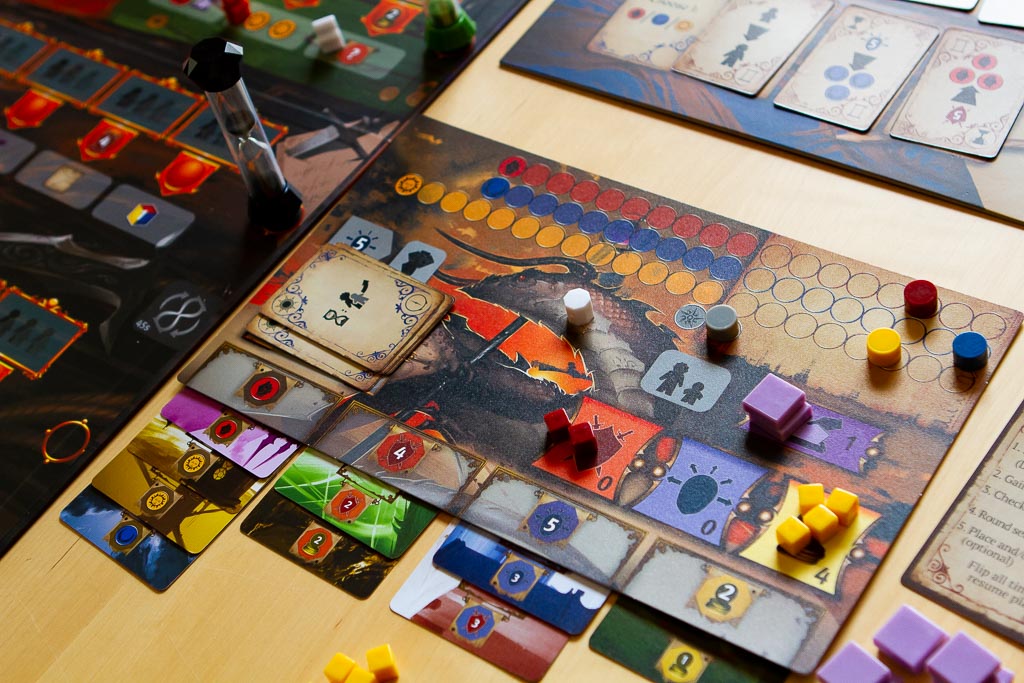
General Feel of the Gameplay
Overall, I really enjoy the general feel of the gameplay when we get Pendulum to the table. It’s an enjoyable experience that feels unique compared to other games because of the utilization of the timers.
Even though the game feels like a solitaire experience, there is enough player interaction to make it interesting. Though, players who really like to keep an eye on things may find this frustrating. At the end of the game, you just have to accept whoever is declared the winner because you weren’t really able to watch how they secured their victory during play.
Special Character Powers
Each character board is double sided with one side having special powers unique from any other character that players can use during the game. This brought even more interesting strategies and possibilities to the game though there is a learning curve to understanding how best to implement them during the game.
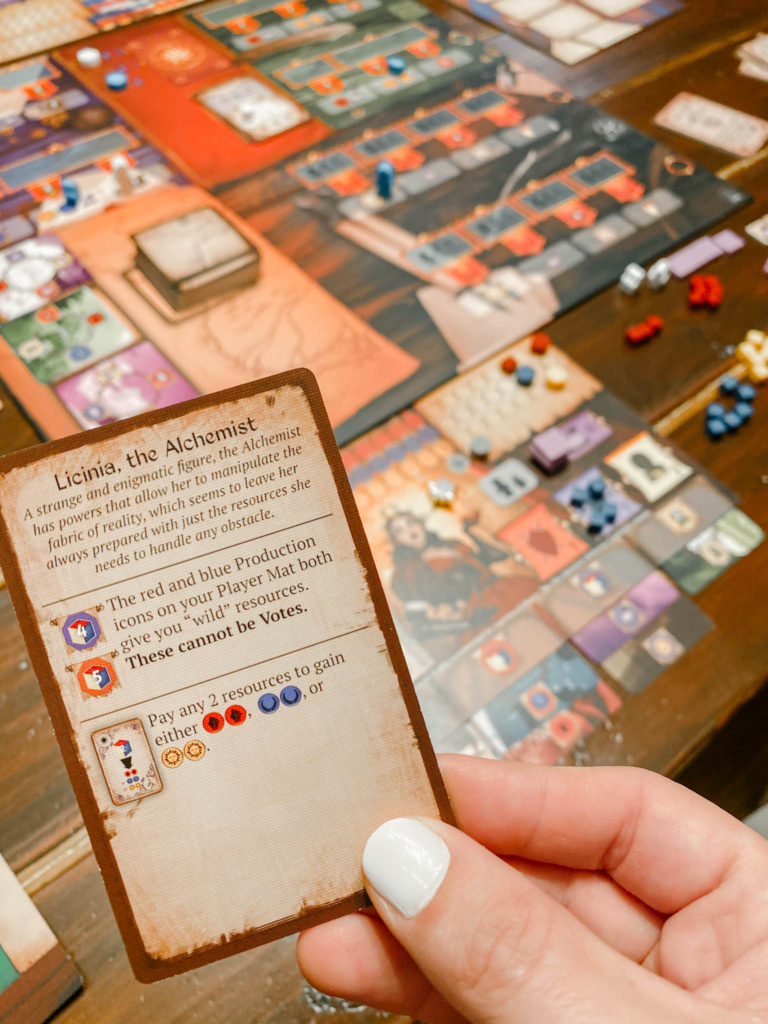
What I didn’t like:
Theme (or lack thereof)
One of the things I love most about Stonemaier Games is their ability to weave theme so beautifully throughout the entire game. Theme is incorporated into every part of Wingspan, I really feel like I’m building a vineyard in Viticulture, and the dystopian world of Euphoria comes through for players to enjoy.
But in Pendulum, there really is no theme to speak of. I’ve even read the rules and I just don’t see how the theme is incorporated into anything. I can’t even force it into existence. This is a straight worker placement game where the theme is completely irrelevant.
Components
The component quality drops here too, a surprising turn for a Stonemaier Game so often known for their beautiful, sometimes over the top component quality. (see Tapestry)
I’m not sure why they went with the plastic meeples as opposed to wooden pieces which always feel more classic and quality. And if you are going to go with plastic, the decision to keep them meeple shaped is just bizarre. They just look weird. Especially the grande worker who’s identity can only be concluded to be Lisa Simpson. It was just a weird choice. Combine that with the large and noticeable mold line that runs the middle and it’s just not a great look.
I’d also be remiss if I didn’t voice my biggest complaint with Pendulum, something that confused me from the moment we opened it and has only bugged me more and more with each play. The game board.
There is so much unused space on this board that I just can’t make sense of why.
While there are gigantic holes of unused space on the board, it still takes up an enormous amount of table space with players still needing to find a spot for the extra game board holding the end of round cards as well as their own personal boards which must have enough space left underneath them so that cards earned during the game can be placed under their slots.
I so greatly wish that this board would have been reworked to not only use the space more wisely, but take up less of the table. I feel at the very least it would have been possible to make the board fit both the timer action spaces as well as the end of round cards and territory cards together. As it stands now, it is just a bit confusing and makes the game play difficult. I mean, the entire middle section of the board is completely unused! I wish all of the timer action spaces would have been in a row together on a longer, more rectangular shaped board perhaps?
Here are two images of the board with one marked up to show the unused space. For reference, our table is 7 foot long and about 3.5 feet wide. Pendulum takes up over half our table and is pretty tight for player resources.
All that being said, I really do like how easily the iconography is to interpret. Everything makes sense as far as where you can go and what you need to pay (if anything) to earn a specific benefit. The action part of the game is very smooth and is nearly able to be understood without the rulebook which is fantastic and helps players got rocking and rolling quickly.
Replayability
While I enjoy playing Pendulum when it hits the table, I’m not itching to get it back. Once the game is over, I’m not thinking about what I could have done differently, or how I’m going to play next time.
Because it’s just an okay game, neither bad nor amazing, I would fear that this will impact it’s replayability in households. Especially if you or someone you play with doesn’t enjoy real time games.
On a related note, this is probably not a game I am going to pull out with a majority of my gaming groups. This is for two reasons.
- The ability to manage time as a resource takes practice, so players who are new to the game will be at a large disadvantage to players with even just a few games of Pendulum under their belts.
- Because the game happens simultaneously, it is nearly impossible to help teach the game as you are playing unless you use the timeless variant. You can’t really pause once everything is going to help clarify rules or help new players understand different strategies. This means it’s easy for players to make mistakes that aren’t caught that can either incorrectly benefit or hurt them.
Okay, Two Last Things:
How does it play with two?
Pendulum plays great with two. Rather than having weird two player rules, the game is just tightened up for two by simply placing an unused character’s meeples on specific sections that will require the two active players to use their grande meeple to access those spaces. This does a great job of simulating the addition of a third player using the actions without requiring different rules.
Overall, it’s a fun game to play together, and I enjoy finding different ways to earn points. Often we both try completely different tactics and end up somewhere around the same spot. So it’s nice that there are truly multiple ways to win.
Often an issue with worker placement games and two players is that you don’t get in each others way too much so it is hard to box people out of certain desirable actions if you have no need for them yourself.
Even though there are a lot of actions available on the board, we still find that we get in each other’s way a lot which makes the game tight and fun. I really like that multiple actions are grouped with a single selection space so that even if were are trying to use different actions, we might take the space and force the other to use their grande worker.
Can kids play?
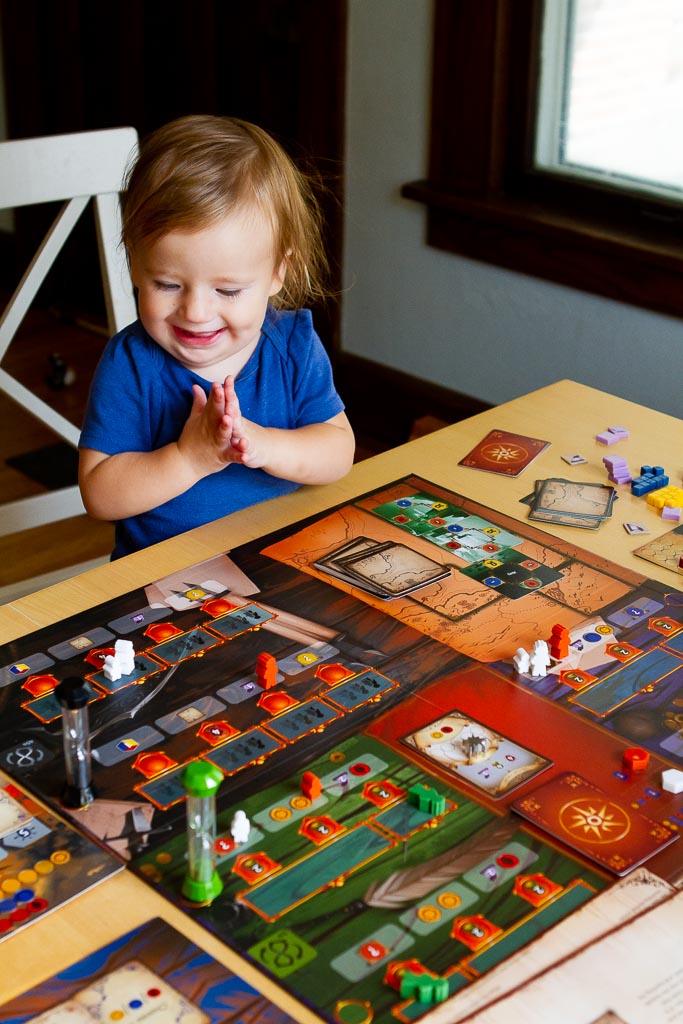
This is not a game I’d recommend to those that far outside of the suggested age of 12. This is due mainly to the use of the timers and the need to make quick decisions. If you are interested in playing with a younger child around age 10 or so, I’d recommend first starting without the timers and using the timeless variant to help guide them through their first few plays.
The iconography overall is very easy to interpret and should be quickly understood by kids with gaming experience.
Summary
Pendulum is an interesting game that will appeal to many players who are fans of real time gaming challenges while most likely turning away those that are not.
The use of timers in the game brings a unique element to worker placement games that provides a satisfying challenge as players try to navigate not only what actions they need to take, but the time they have to take them.
While I worry about the longevity of the game and had some issues with the design, I do enjoy playing it each time it hits the table. If you are a fan of real time games, or have experience with worker placement and are looking for a fun and engaging new challenge I recommend at least giving Pendulum a try.
To bring home a copy of Pendulum you can find it here.
Find all our favorite games for all ages on our Amazon Storefront!
A special thank you to our friends at Stonemaier Games for sending us a copy of Pendulum for review. As always, our thoughts and opinions are our own.
Game Info:
Title: Pendulum
1-5 Players Ages 12+
Designer: Travis P. Jones
Artist: Robert Leask
Publisher: Stonemaier Games
If You Enjoyed This Post You May Also Like
Sorcerer City
Pandemic Rapid Response
Viticulture with Tuscany Expansion

